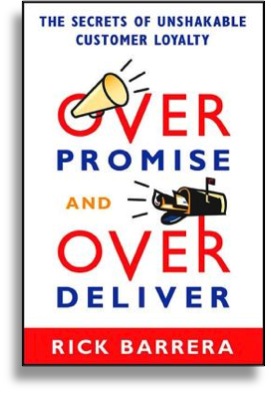7 MORE Ways to Keep Your Clients and
Customers Coming Back
by Adele Sommers
 In the book Overpromise
and Overdeliver: The Secrets of Unshakable Customer Loyalty by Rick Barrera, we learn how a wide range of product and service companies emerged
from a completely unknown state to eventually dominate their markets, all
without expensive advertising. In the book Overpromise
and Overdeliver: The Secrets of Unshakable Customer Loyalty by Rick Barrera, we learn how a wide range of product and service companies emerged
from a completely unknown state to eventually dominate their markets, all
without expensive advertising.
These businesses offered highly ambitious
promises at first to lure customers in, then over-delivered on those promises to keep buyers coming back for more. The companies’ focus on novelty, quality, and stellar customer service at all costs worked together to create legions of raving fans.
In Part 1 of this series, we began exploring how to anchor customer loyalty with the first two of three types of tips:
- Product and service design
- Evaluation and testing
- Customer satisfaction
This article, Part 2 in the series, covers the third category of ideas. As before, each idea appears as a question so that you can gauge your own organization’s response.
Category 3: Customer Satisfaction
8. How consistently do you follow through on your advertised claims, promises, and guarantees?
 Promises, promises, promises... As consumers, we find them irresistible, and they often give us a justification for trying something new! Promises, promises, promises... As consumers, we find them irresistible, and they often give us a justification for trying something new!
Do you create products or services to sell to others? Have you considered that if you strive to consistently under-promise and over-deliver, you will inspire far greater confidence in your clients and customers, and delight them in ways that far surpass expectations? This is a far better outcome than what happens when your wares don’t comport with your words!
Why does this matter? Consider that trust is the currency of consumer decisions, and that credibility and trustworthiness evaporate whenever we make promises we can’t keep.
In terms of advertised claims, promises, and guarantees, this means meeting or exceeding the stipulated delivery dates and times, service standards, quality levels, product features, performance speed, and so on. So, whenever we wow customers by consistently following through — and we offer a meaningful, sincere, and timely resolution if something goes wrong — it creates the kind of customer loyalty that most companies would die for.
9. How frequently do you poll your customers about their experiences with what you offer?
 Do you “take the temperature” of your clientele? Engaging in regular “how are we doing?” dialogs will serve your organization well. If you ask customers what they love and don’t love about your products, services, or systems, you’re inviting honest feedback that you can turn into loyalty-boosting improvements. Do you “take the temperature” of your clientele? Engaging in regular “how are we doing?” dialogs will serve your organization well. If you ask customers what they love and don’t love about your products, services, or systems, you’re inviting honest feedback that you can turn into loyalty-boosting improvements.
Why does this matter? Since customers frequently ignore surveys, incentivizing people to give feedback — except when they are angry — can be challenging.
An alternative approach involves engaging in “tell us how we can improve” conversations, such as when your service representatives chat with customers during routine transactions. By asking them for their candid comments — without becoming defensive — you can cement deeper relationships, as well as gain valuable ideas for increasing customer satisfaction and loyalty.
10. How frequently do you poll your customers about their experiences with your personnel?
 Asking your customers to rate how well your staff are serving their needs will reveal your customers’ real levels of “emotional satisfaction” with your business. According to Gallup research, this is a major factor in bottom-line performance and profitability. In fact, this single dimension of employee–customer engagement is one of the greatest predictors of business success! Asking your customers to rate how well your staff are serving their needs will reveal your customers’ real levels of “emotional satisfaction” with your business. According to Gallup research, this is a major factor in bottom-line performance and profitability. In fact, this single dimension of employee–customer engagement is one of the greatest predictors of business success!
Why does this matter? Over decades of gathering organizational data, the Gallup Organization identified the highly predictive nature of customers’ levels of emotional satisfaction. The most powerful type of emotional satisfaction derives from the helpfulness of the staff of businesses that provide products and services. In fact, customer satisfaction with staff members is a far more potent and enduring indicator than is customer satisfaction with just the products and services alone.
These findings suggest that systematically collecting, analyzing, and working with the data on your customers’ experiences with your staff could be a very effective way to boost your bottom line.
11. How consistently do your data show that your customers are thrilled with your products and services?
What do your buyers really think about your offerings? First of all, it’s essential that they perceive that they are experiencing “quality in fact.”
 That’s when your products and services function exactly the way they’re meant to, per all of your advertised promises, claims, and guarantees. That’s when your products and services function exactly the way they’re meant to, per all of your advertised promises, claims, and guarantees.
It’s one thing to believe that this is the case, but it’s another to prove that your buyers perceive things this way.
Why does this matter? Regardless of how fantastic you think your products and services are, customers respond to both “quality in perception” and “quality in fact.”
- Quality in fact refers to the features that consumers believe they’re paying for based on your marketing material, such as how fast something runs, how many and what types of buttons it has, how long it’s guaranteed to operate, and so on.
- Quality in perception refers to a wide range of other subtleties, such as exceptional ease of use, special courtesies and considerations, and a caring and personalized attitude. These can lead consumers to sense that they’re receiving something above and beyond what they’re actually paying for.
Note that effective quality in perception is not a substitute for quality in fact. But it can help compensate for any gaps in quality in fact that could otherwise irritate or inconvenience consumers. And the combination of both types of quality is what produces intensely loyal, raving fans!
12. How consistently do your data show that your customers are thrilled with your personnel?
 As mentioned previously, Gallup found that there is a predictive power in the levels of emotional satisfaction that your customers have with your personnel. The customers who experience the most rewarding relationships buy 184% more than (nearly twice as much as) the customers who are merely satisfied with your products and services. As mentioned previously, Gallup found that there is a predictive power in the levels of emotional satisfaction that your customers have with your personnel. The customers who experience the most rewarding relationships buy 184% more than (nearly twice as much as) the customers who are merely satisfied with your products and services.
Why does this matter? Customers who are engaged at this level have forged a personal bond with at least one employee, based on a consistently caring and helpful relationship, Gallup’s research revealed.
In industries ranging from high tech to banking to fashion, highly engaged customers have the strongest desire to continue doing business — in greater volume, with more transactions, and over a longer period — than other customers. These findings suggest that employees’ rapport-building skills are worth their weight in gold. But note that customers also must be satisfied with your company’s products and services to demonstrate this level of loyalty!
13. What proportion of your sales comes from existing customers placing new orders?
 Customer retention research shows that once your company has loyal customers, the cost of keeping them is one-fifth the cost of attracting new ones. And, it’s possible to boost profitability substantially just by increasing customer loyalty by only a small amount! Customer retention research shows that once your company has loyal customers, the cost of keeping them is one-fifth the cost of attracting new ones. And, it’s possible to boost profitability substantially just by increasing customer loyalty by only a small amount!
Why does this matter? Marketing research illustrates the revenue-generating power of existing customers. This classic Forbes article describes how companies often believe that an excellent product or service, plus outstanding customer support, will automatically lead to customer retention. In reality, your company must perpetually earn its customers’ loyalty.
But consider the potential for generating repeat sales from your loyal customers, based on the findings from these sources:
- A 5% increase in customer retention can increase your company’s profitability by 75% (Bain & Company).
- As much as 80% of your company’s future revenue will come from just 20% of your existing customers (Gartner Group).
- Capturing a new customer will cost your company five times more than retaining an existing one (Lee Resource Inc.).
That’s why it’s so valuable to monitor how many of your new orders represent repeat business, since that data represents one of the keys to your financial growth.
14. What proportion of your sales comes from customers who are referred by others (via word of mouth)?
 As avid users of social media know, word of mouth recommendations are a powerful way to cultivate a base of passionate, loyal buyers who can’t wait to rave to everyone they know about what you offer. As avid users of social media know, word of mouth recommendations are a powerful way to cultivate a base of passionate, loyal buyers who can’t wait to rave to everyone they know about what you offer.
Why does this matter? In case you’ve wondered just how often consumers tell others about their experiences with the products and services they’ve bought, the article 50 Essential Facts about Consumer Behavior reveals the eye-opening answers.
What triggers most of the customer sharing is how well people felt they were treated by customer service personnel whenever they have had a need to report a problem.
- When customers have negative experiences, they tell 9 to 15 people about it, and some tell as many as 20. (Note that 96% of them won’t ever complain to the company itself, and 91% of those simply leave and never come back.)
- On the flip side, when customers have positive experiences, they will likely tell only 4 to 6 people. So, that’s one reason why measuring word-of-mouth referrals and sales is so important. It’s a reflection of how much flattering buzz is circulating about your products and services, and how well your customer support team is cementing highly positive customer relationships.
In conclusion, by using just a few of the 14 techniques we have covered in this series related to product and service design, testing and evaluation, and customer satisfaction, your business is sure to experience a bottom-line boost and a stellar reputation for quality, integrity, and customer care!
Copyright 2019 Adele Sommers
|


